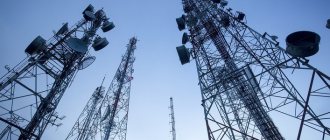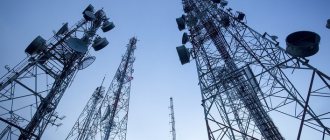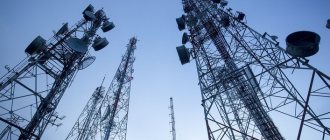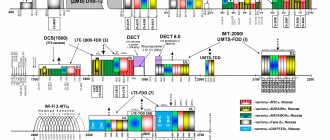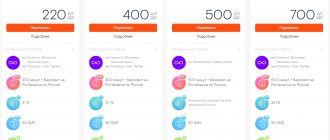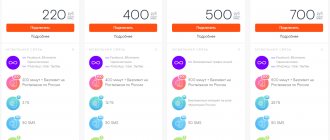Today, Russian mobile operators are actively expanding the coverage area of fourth generation networks. LTE is a term used to refer to networks with a throughput of at least 10 Mbps. 4G networks are a new communication standard, which is characterized, first of all, by fast connections and high quality voice calls.
List of LTE frequencies used by Russian mobile operators
The 4G networks of each domestic operator are located in a certain frequency range. The presented table contains information about LTE bands (from the English Band), which are supported in our country:
| Band name | Frequency |
| Band 3 | 1800-1880 MHz |
| Band 7 | 2620-2690 MHz |
| Band 20 | 790-820 MHz |
| Band 31 | 450 MHz |
| Band 38 | 2570-2620 MHz |
The LTE standard is not compatible with second and third generation networks, so special data transmission channels were allocated for it. Band is the frequency bands of any LTE network. The band number indicates the period when the given range began to be used in the world (there are currently 44 bands).
The bands presented in the table are used by each cellular operator. It should be noted that these frequency ranges are constantly expanding, which allows providers to provide Internet connections to a larger number of users.
In some cases, operators unite to build cell towers: a similar agreement was concluded in 2021 by Beeline and Megafon. Another example of cooperation was the agreement between Beeline and MTS, according to which the operators use common frequencies in the territory of some constituent entities of the Russian Federation.
The acquisition of bend frequencies occurs through open bidding, in which providers buy the right to broadcast their signal on certain channels. MTS, for example, spent 4 billion rubles on the 2500 MHz band, distributed throughout the Russian Federation except the Moscow region and Crimea. Tele2 was the first to launch 4G in the Kaliningrad region and a number of other regions of our country at a frequency of 450 MHz.
Second generation cellular communications (2G)
Continuous numbering of bands was introduced to describe the 3G and 4G (LTE) standards, however, in some cases in the literature you can find references to GSM Band 3 or GSM Band 8. Since GSM networks use the same frequencies as later generations of communication, it becomes possible the use of band numbering is analogous, therefore in the case of GSM networks it is more correct to talk about “equivalent bands”. More often, GSM bands are recorded simply indicating the frequency (for example, GSM-900 or GSM-1800).
GSM-900
Uplink: 890-915 MHz Downlink: 935-960 MHz
The most common GSM standard, operating at a frequency of 900 MHz. The low frequency provides an excellent signal range of up to 30 km, allowing operators to create a carpet of reliable voice communications. GSM-900 works both in cities and in rural areas, including remote settlements. 2G communication accompanies vehicle drivers when driving on federal and intercity highways. Classic GSM-900 networks are used by all operators except Tele2.
GSM-900 amplification equipment
GSM-E900, EGSM (Extended GSM), GSM Band 8
Uplink: 880-915 MHz Downlink: 925-960 MHz
Unlike the simple GSM-900, this enhanced 2G standard received an additional 10 MHz in the incoming and downstream channels. The emergence of EGSM is directly related to the excessively intensive use of “classical” GSM in cities. At a certain point, operators needed additional frequency resources, which were allocated by government agencies for the needs of cellular communications.
GSM- 1800, DCS-1800, GSM Band 3
Uplink: 1710–1785 MHz Downlink: 1805–1880 MHz
An alternative frequency range for second generation networks, operating at 1800 MHz. Unlike GSM-900, GSM-1800 is most often found in cities and large populated areas and is not used for carpeting areas. The standard was introduced gradually as a response to the lack of free bands in GSM-900 networks. The expansion of ranges over time is due to both the emergence of new standards and the growth in the number of subscribers, as well as the emergence of new operators in the mobile communication services market. GSM-1800 networks are used by all operators, including Tele2 (except for Moscow, where the operator has not received a license for this range).
GSM-1800 amplification equipment
As noted above, to designate 2G standards, a letter nomenclature with a numerical value of the data transmission frequency is usually used. However, occasionally there are attempts to apply a universal nomenclature of bands used for 3G/4G communications. In this notation, GSM-E900 networks correspond to GSM Band 8, and GSM-1800 networks can be called GSM Band 3.
4G LTE networks in Russia
Now you can familiarize yourself with the table, which presents the current characteristics of fourth generation networks in the Russian Federation.
| Operator | Frequency (upload/download), MHz | Duplex | Band |
| Yota | 2500-2530 / 2620-2650 | FDD | Band 7 |
| Megafon | 2530-2540 / 2650-2660 | FDD | Band 7 |
| Megafon | 2575-2595 | TDD | Band 38 |
| MTS | 2540-2550 / 2660-2670 | FDD | Band 7 |
| MTS | 2595-2615 | TDD | Band 38 |
| Beeline | 2550-2560 / 2670-2680 | FDD | Band 7 |
| Tele2 | 2560-2570 / 2680-2690 | FDD | Band 7 |
| MTS | 1710-1785 / 1805-1880 | FDD | Band 3 |
| Tele2 | 832-839.5 / 791-798.5 | FDD | Band 20 |
| MTS | 839.5-847 / 798.5-806 | FDD | Band 20 |
| Megafon | 847-854.5 / 806-813.5 | FDD | Band 20 |
| Beeline | 854.5-862 / 813.5-821 | FDD | Band 20 |
In addition to the five federal operators, there are also regional ones, each of which has its own frequency network.
Which providers provide LTE services to subscribers?
Today, almost all domestic mobile operators use the 4th generation communication standard in their work and provide corresponding services to users.
Such providers include
- Yota . The first company to master and launch LTE in the Russian Federation. As of 2011, it had 63 base stations. Yota's 4G frequency occupies channel band 7.
- Megafon . Megafon began working with 4G in 2012. Today the coverage area covers almost the entire country. The company's equipment operates at frequencies b7, b38 and b20 (in the 7.5 MHz range, which does not quite correspond to the b20 standard).
- MTS . Provides LTE services in 83 regions of the country. Uses the 4G frequency FDD b7, as well as b20 and b38 (in all regions of the Russian Federation, except Moscow and the region, as well as the Autonomous Republic of Crimea and Sevastopol).
- Tele2 . Successfully promotes new generation communication technology, uses the b3 band.
- Beeline . Official Beeline 4G frequencies b7 and b20.
This list is completed by Rostelecom, the Crimean operator Volna-Mobile, and the young provider Motiv.
Large companies use several bands.
MTS 4G frequencies occupy:
- b3 is LTE 1800;
- b7 or LTE 2600;
- b20 refers to LTE 800;
- b31 operates at latitude 450.
Megafon's LTE frequencies are allocated to a separate channel, which allows us to provide the best quality of communication to subscribers.
Upper and lower frequencies
From a financial point of view, the development of LTE networks at lower frequencies (less than 2000 MHz) is most profitable for operators. Such frequencies penetrate buildings better, but are not able to provide high-speed connections to areas with high population density.
The functions of the upper frequencies are opposite to the functions of the lower ones, so the best option for a high-quality connection is a combination of both frequency channels, which allows you to get rid of “shadow” areas over large spaces.
Also in megacities, there is a tendency to install special devices on the roofs of office buildings to facilitate the spread of high-speed networks indoors.
Basic LTE modes
The LTE standard is divided into two types: TDD and FDD.
The first implies temporal (from the English Time) division of the signal, and the second - frequency (from the English Frequency). FDD is a more convenient communication mode because, from the point of view of everyday use, it is more stable.
The difference between these concepts lies in the method of loading and unloading data. Thanks to FDD, parallel processing of incoming and outgoing Internet traffic occurs.
Imagine that a user is watching a video on YouTube and at the same time uploading an entire album of photos to the cloud storage. Watching a video will be considered a download operation, and sending a photo will be an upload, and in FDD mode the gadget distributes both operations over different frequency channels.
For example, LTE from the Russian Megafon operates at a frequency of 17 MHz, 11 of which can be used for downloading content, and the remaining 6 for uploading.
Separate traffic processing increases the stability of the speed of each individual process, thereby ensuring a better connection.
TDD processes traffic sequentially. In other words, over the same 17 MHz, both downloading and uploading of data will be carried out - but without separation, but alternately in one channel. The disadvantage of this mode is possible “jumps” in speed.
Currently, Russian cellular operators are striving to combine the operation of TDD and FDD stations. By combining modes into one network, providers increase the overall connection speed.
LTE amplification equipment
To boost the 4G signal with frequency division (LTE FDD), there are kits of varying power and performance. If you need to improve the quality of mobile Internet on WiFi-enabled devices (smartphones, tablets), we recommend using a kit with a passive amplification principle - for example, Dacha-Standard. These kits are based on an efficient transmitting and receiving antenna that is connected directly to a 4G modem.
If you need to improve the signal quality on cellular devices without using WiFi, you should purchase a kit based on an active amplifier - repeater. In most cases, the BS-4G-75-kit from the domestic plant Baltic Signal is suitable.
There are significantly fewer solutions for amplifying 4G time division standards (LTE TDD) on the market and they are mainly represented by sets with passive amplification. We recommend paying attention to the Huawei B315 router with an external antenna, which provides support for LTE TDD at 2600 MHz.
If you need a modem that supports LTE TDD, then you should pay attention to the ZTE MF79, ZTE MF825, ZTE MF831, Huawei E392 and Huawei E8278s models. All of the listed modem models (except for the budget ZTE MF79) have connectors for connecting an external antenna, which can be used to improve the quality and reliability of the mobile connection. Also, support for time division is widely available in Huawei portable routers, including the E5770, E5885, E5787 and E5788. Models E5787 and E5788 also have connectors for an external antenna, so they can be used to create a 4G Internet amplification system.
LTE-advanced technology (4G+)
LTE-advanced is an “advanced” 4G network and is designated by Russian operators as 4G+. Although this name emphasizes the increase in speed of the new standard, it is not correct, since LTE-A in its actual performance is regular 4G. What is called 4G in Russia is significantly inferior to the nominal standards of fourth generation networks.
The advantage of the advanced standard is the summation of all frequencies owned by the cellular operator, which reduces the “sag” factor in the data transmission channel. By merging several band 7 bands into one, Megafon was able to increase the theoretical connection speed to 300 Mbit/s.
If we add band 3 frequencies to the frequencies of band 7, then the data transfer speed will be 450 Mbit/s (40 MHz + 20 MHz = 300 Mbit/s + 150 Mbit/s). Unfortunately, the actual throughput of advanced channels is lower than declared and corresponds only to nominal 4G standards.
Any cellular operator that has the appropriate license and the necessary equipment can use various frequency channels. Now there is a tendency to expand channel capacity, the volume of which depends on the frequency range. It is also worth noting that to support LTE-A, the user’s device must have special technical characteristics.
What is an LTE band?
In simple terms, bands correspond to certain frequency ranges used in cellular communications. Thus, LTE Band 7 means that the 4G mobile network operates in the 2600 MHz band. A complete list of approved bands and frequencies can be easily found in reference literature or open Internet sources.
In addition to the main frequency of receiving and transmitting data, each band has a set of associated unique characteristics, such as available channel width and duplex mode. For example, some bands are designed for the Frequency Division Duplex (FDD) mode, in which data reception and transmission occur at different frequencies, while others are designed for the Time Division Duplex (TDD) mode, when reception and transmission carried out at the same frequencies alternately.
Cellular bands in Russia may not correspond to bands used in other countries. There are 88 LTE bands in total, but in practice only a few are used in each country. The allocation of certain frequencies for the needs of mobile operators occurs at the state level and usually takes into account the features of the existing infrastructure for special, military and civil communications.
Let's look at what cellular communication bands are used in Russia!
4G speed
It is worth understanding that the actual connection speed almost always differs from the nominal one. The theory does not take into account factors such as landscape, remoteness of cell sites, or the presence of the user in the building - such conditions interfere with the connection and significantly reduce its quality.
The speed of data transfer also depends on the operator’s workload: the more users have access to fourth-generation networks, the lower the speed indicators. The speed of the Internet connection in wireless networks is determined by the width of the frequency range, as well as the implementation of the communication duplex.
These specifications vary by operator. Although some providers guarantee 300 Mbit/s, the average actual speed is only 75 Mbit/s (Tele2, MTS and Beeline).
The already mentioned tandem of Beeline and Megafon recently began the transition to the LTE-advanced standard, which made it possible to increase speed to 160 Mbit/s in some coverage points.
Now such a standard is presented in Moscow and St. Petersburg, but the regions will have to wait a long time for it: the total distribution of 4G+ throughout Russia is now impossible for two reasons.
The first is the cost of the required equipment, and the second (follows from the previous one) is that as the coverage area increases, the load on existing cell towers will increase, that is, the average speed will only decrease.
Since the speed of the connection depends on the width of the frequency range, we can say that today Megafon is in the most advantageous position, which, after absorbing Yota, added channels of the acquired company to its own frequencies.
Theoretically, the Megafon network can operate on a 40 MHz channel and accelerate in FDD mode to 300 Mbit/s, but since part of the channel is given to subscribers of the subsidiary Iota, the actual speed is approximately 100 Mbit/s.
If we compare networks of the third and fourth generations, the latter have several times higher speeds: an average of 80 Mbit/s versus a maximum of 3 Mbit/s. HSPA+ was able to overclock 3G to 45 Mbps, but these figures still lag behind 4G.
Is Band 20 needed in Xiaomi?
How important Band 20 is for owners of popular Chinese Xiaomi smartphones is a purely individual question and is related to the ease of using 4G communications in a particular region/locality.
In any case, if you live in Russia, you have chosen a phone from this manufacturer and you want to get the highest possible Internet connection speed, carefully read the specifications of the selected model.
It is best if it indicates support for the four main Russian LTE bands: Band 3, 7, 20 and 38. This is ideal. The minimum configuration for more or less comfortable use is the presence of ranges 3 and 7.
If Band 20 support is not specified in the mobile phone specification, then LTE coverage in suburban areas and mountainous areas will not be available. And those living in the metropolis will have access to high LTE frequencies.
One way or another, in the conditions of modern Russian realities, Band 20 is certainly needed. First of all, because you will not be able to find more or less accurate information about what the coverage area is in various cities and regions of the Russian Federation. This can only be verified in practice, on your own.
The second reason: the presence of a second - backup - frequency will be a big plus. By purchasing a smartphone without Benda 20 support, you will not lose connection, but in sparsely populated areas, certain mobile operators will work worse or may not work at all.
Further development of LTE
Despite the launch of testing of fifth generation networks in the world, some regions of the Russian Federation still do not even support 3G. In connection with this circumstance, it is worth predicting, first of all, the widespread development of LTE technology. Also, fourth-generation networks represent a non-alternative way of accessing the Global Wide Web in a number of Russian regions, which encourages domestic cellular operators to develop the 4G standard.
In some cases, a wired connection is simply impossible, which contributes to the spread of wireless technologies: the capabilities of cellular stations can be expanded thanks to special signal repeater antennas. The user can independently purchase such an antenna. It is important to consider that each repeater only works with certain frequencies and mode (FDD or TDD).
How to check for Band 20 in Xiaomi?
Having understood the theory of signal propagation of LTE networks, frequency ranges and where certain wave spectrums can be used in Russia, let’s move on to how to find out whether the Xiaomi Band 20 phone supports it.
As mentioned above, you can check its presence in your phone by reading the specifications for the model you have chosen. Let's look at the example of choosing Xiaomi Redmi Note 3 Pro. Here are the related characteristics of this model:
| Technology | GSM/LTE/HSPA |
| 2G Bands | GSM 850/900/1800/1900 |
| 3G Bands | HSDPA 850/900/1900/2100 [SE, Taiwan] HSDPA 850/900/1700 (AWS)/1900/2100 [Global] |
| 4G Bands | LTE Band 1 (2100), 2 (1900), 3 (1800), 4 (1700/2100), 5 (850), 7 (2600), 8 (900), 20 (800), 28 (700), 40 (2300) [SE, Taiwan] |
| Speed | HSPA 42 2/5 76 Mbps, LTE-A Cat-6 300/50 Mbps |
Judging by the specified characteristics, 3G communication in Russia will be carried out almost perfectly. But with 4G everything is not so rosy: there is a 3b- and 7b-base, but there is no support for b20. In this case, there is support for Bend 28, and the category parameter is 6 (Cat6).
From this it becomes clear that the phone will have a good, but by no means exorbitant speed. In zones b20 some interference may be observed.
